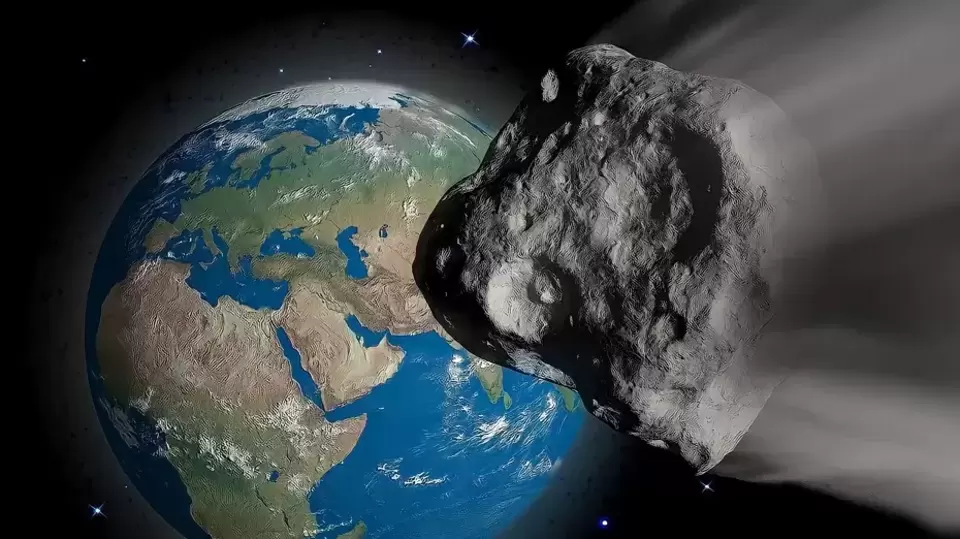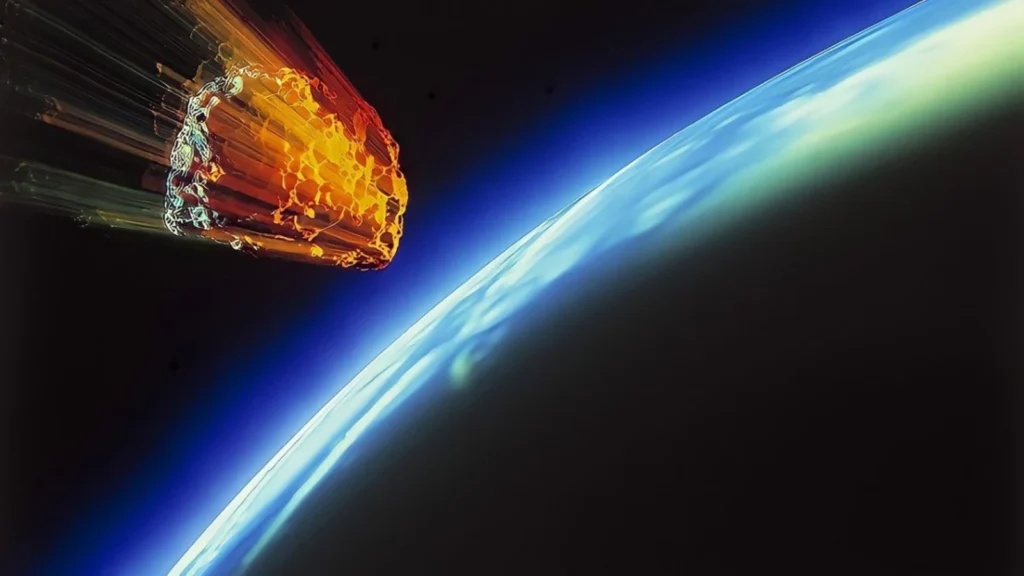Numerous celestial bodies flow quietly through wide space. One such type is asteroids, which are rocky remains from the early solar system that sometimes intersect with Earth’s orbit. Recently, NASA has issued a warning about a large asteroid about as long as blue whale hurtling towards Earth at a surprising speed of 30,381 kilometers per hour (18,870 miles per hour). The 110-foot asteroid is probable to come very close to our planet and concerns have been raised by both scientists and the public alike. Here’s all we know about this asteroid so far plus its trajectory and possible impact along with what it means for science.

Asteroid Overview: Size and Speed
Dimensions and Composition
The specific asteroid in question is around 110 feet (33 meters) long — roughly equal to the length of a blue whale, which happens to be the largest animal on earth. Such massive space rocks are comparatively small compared to some other gigantic asteroids roaming in our solar system but are still large enough for us to keep a close watch due their possible collision impacts with terrestrial bodies.
Velocity and Trajectory
At an unbelievable velocity of over thirty thousand kilometers per hour (nearly eighteen thousand miles per hour), this object moves almost twenty-five times faster than sound itself! Its high rate of travel has been carefully monitored by NASA’s Planetary Defense Coordination Office – an agency charged with detecting tracking characterizing potentially hazardous asteroids comets that could threaten life on earth.
Discovery And Monitoring
Discovery Details
NASA’s Near Earth Object (NEO) Observations Program discovered the object using telescopes across its network along other advanced systems for tracking celestial bodies. The detection was made via some ground-based instruments coupled together with outer space observatories thus enabling accurate computation concerning its orbit path plus speed.
Continuous Observation
Since then constant vigilance has been maintained over this celestial body. Astrobiologists employ sophisticated algorithms together model predictions regarding possible near misses between such objects like these ones against our home world. The ongoing scrutiny plays an important role in comprehending how NEOs move through different regions within our solar neighborhood while estimating their risk levels whenever they approach closer proximity toward us.
Close Approach To Earth
Date And Distance From Earth
On [Insert Date if known],the said rock will get closest to earth passing within [Insert Distance].Although alarming sounding, this distance remains sufficiently far away hence posing no immediate danger whatsoever.

Collision Likelihood Assessment
-NASA determined that chances are extremely low when it comes down whether or not this particular NEO will hit us anytime soon.Scientists intend collecting valuable data during such events without having any significant risks involved.A reminder should always be there reminding people about importance continual monitoring preparedness planetary defense efforts against future collisions involving similar entities.
Scientific Significance Of Research Opportunities
Planetary Defense Innovations
Planetary defense relies heavily on studying near-Earth objects (NEOs) like this asteroid. Scientists monitor these objects to create and improve strategies for reducing possible threats. This includes technologies that can disrupt or deflect asteroids with a high chance of hitting Earth.
Informing the Public and Teaching Them
Such events also serve an educational function by increasing public awareness of asteroids and space research in general. They emphasize what has been done by space agencies to keep our planet safe while stirring interest in astronomy among ordinary people.
Technological and Observational Advances
Observatories on the Ground
Detecting and tracking asteroids is largely accomplished through ground-based observatories. The Pan-STARRS (Panoramic Survey Telescope and Rapid Response System) facility located in Hawaii, as well as Arizona’s Catalina Sky Survey are leading the way in discovering new asteroids. Powerful telescopes scan the night sky for moving objects at these observatories, giving early warnings about potential hazards.
Telescopes in Space
NASA’s NEOWISE (Near-Earth Thing Wide-field Infrared Survey Explorer) is one of several space-based telescopes that work alongside ground-based efforts by observing asteroids using different wavelengths of light. This helps geniuses get better insights into an object’s size, structure, and route.
Models Using Advanced Computing Techniques
Advanced computational models predicting future positions of asteroids use data collected from these observatories. Various factors are considered when making predictions including the gravitational influence from planets or Tarkovsky effect which refers to a force acting on rotating bodies within space caused by heat emission.

Possible Impact Events Effects After An Impact
Though this particular asteroid hitting Earth may have low probabilities attached to it; understanding impact consequences remains important anyway. A significant localized damage could result if such a large sized object were ever to strike a populated region since its impact would release massive amounts energy comparable to several nuclear bombs resulting into widespread destruction over vast areas.
Strategies For Mitigation
Mitigation strategies can be developed based on understanding potential impact scenarios Current planetary defense efforts include investigating ways that could help divert or destroy any asteroid traveling towards earth Kinetic impactors (spacecraft designed specifically collide with an asteroid alter its trajectory) gravity tractors(space crafts using their own gravitational pull change course.
Public Safety And Readiness
Risk Communication
For public safety preparedness communication about risks associated with asteroid impacts is vital. NASA along other space agencies strive to ensure accurate timely information reaches both communities authorities concerned This involves updates regarding trajectories probabilities likely consequences.
Educational Initiatives
Earth protection measures taken need more attention raised through initiatives aimed at creating awareness among people about important planetary defense programs. Education science related outreach activities should be used to inform people monitoring ongoing works regarding mitigating possible threats posed by asteroids.
Emergency Preparedness
Emergency attention is still necessary, even though the odds of a major asteroid striking Earth are low. Governments and establishments develop plans and rules for potential impacts. This also includes working with other nations to prepare for a possible mutual threat.
Conclusion
A 110-foot asteroid careering toward our planet at 30,381 kilometers per hour (18,870 miles per hour) is an fascinating and significant celestial existence that highlights the need to continuously monitor near-Earth objects (NEOs) through research on them. While it poses no immediate danger, its proximity gives scientists a chance to study it more closely and educate the public about such events. NASA’s persistent tracking of these space rocks ensures we’re ready in case one ever threatens us again. As technology progresses and observation methods improve over time, so too will our capacity to detect and monitor mitigate asteroids which will further strengthen global defense against them.
FAQs
1. How large is this asteroid compared to things we know?
The 110-foot long asteroid is approximately equal in size to a blue whale—the largest animal alive today.
2. At what speed does this asteroid travel?
The 30 thousand three hundred eighty-one kilometers per hour (18 thousand eight hundred seventy mph) flying object moves through space like lightning.
3. Is there any possibility that it could collide with earth?
No; according to NASA’s calculations based on its trajectory analysis techniques employed during previous missions involving similar objects have shown no risk whatsoever from such encounters between our planet itself along with all other celestial bodies orbiting around the Sun including ourselves as well.
4. Why should we study asteroids that pass nearby planets?
Understanding more about those kinds of rocks can provide information regarding their structure composition behavior which will allow us better forecast if they may pose danger sometime later.
5. How does NASA keep track of NEOs?
A network consisting mainly telescopes placed strategically across different locations worldwide connected together via communication systems enabled by computers used by scientists working at various institutions involved in this field provides detailed information concerning orbits size shape materials making up these objects thus allowing early warning signs detection followed by accurate predictions about what might happen next after discovery has been made concerning any given NEO detected earlier within solar system vicinity surrounding Earth itself where humans live daily life activities without worrying much because everything seems alright until proven otherwise.

